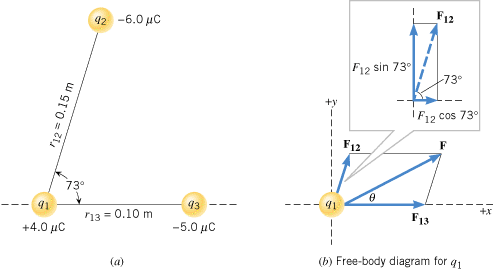|
Figure 18.14a shows three point charges that lie in the x, y plane in a vacuum. Find the magnitude and direction of the net electrostatic force on q1.
 | Figure 18.14
(a) Three charges lying in a plane. (b) The net force acting on q1 is F = = F12 F12 + + F13. The angle that F makes with the +x axis is q . F13. The angle that F makes with the +x axis is q . |
|
Reasoning
The force exerted on q1 by q2 is F12 and is an attractive force because the two charges have opposite signs. It points along the line between the charges. The force exerted on q1 by q3 is F13 and is also an attractive force. It points along the line between q1 and q3. Coulomb’s law specifies the magnitudes of these forces. Since the forces point in different directions (see Figure 18.14b), we will use vector components to find the net force.
Problem solving insight
The electrostatic force is a vector and has a direction as well as a magnitude. When adding electrostatic forces, take into account the directions of all forces, using vector components as needed. |
|
Solution
The magnitudes of the forces are
The net force F is the vector sum of F12 and F13, as part b of the drawing shows. The components of F that lie in the x and y directions are Fx and Fy, respectively. Our approach to finding F is the same as that used in Chapters 1 and 4. The forces F12 and F13 are resolved into x and y components. Then, the x components are combined to give Fx, and the y components are combined to give Fy. Once Fx and Fy are known, the magnitude and direction of F can be determined using trigonometry.
Force
|
x component
|
y component
| |
F12  
|
   +(9.6 N) cos 73° +(9.6 N) cos 73° = = +2.8 N +2.8 N
|
   +(9.6 N) sin 73° +(9.6 N) sin 73° = = +9.2 N +9.2 N
|
F13  
|
+18 N
|
0 N
|
F    
|
Fx = = +21 N +21 N
|
Fy = = +9.2 N +9.2 N
|
The magnitude F and the angle q of the net force are
|


